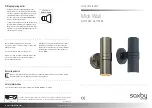
- 45 -
5.2
Preventing low loads
5.2.1
General
All engine parts are designed with tolerances to allow
work under full load conditions. When operating at
low load, these tolerances allow more lube oil to pass
between valve guides, stems, liners and pistons due to
the lower engine temperatures.
Lower combustion pressure has an influence on the
piston ring operation and the combustion
temperature. Low boost pressure will cause oil
leakage over the turbo shaft seal.
5.2.2
Risks of low load operation
– Cylinder glazing: the cylinder bore troughs
become filled with lacquer, displacing oil and thus
preventing correct ring lubrication.
– Bore polishing: the bore surface becomes
polished, all peaks and most troughs become worn
away, also preventing correct ring lubrication.
– Heavy carbon build-up: on pistons, piston ring
grooves, valves and turbo charger. Carbon build-
up on pistons can cause seizure when later
operating at full load.
– High oil consumption: prolonged no-load/low
load operation of the engine may cause it to blue/
gray smoke at low rpm with an associated increase
in oil consumption
– Low combustion temperature: this will result in
insufficiently burnt fuel, which will cause diluting
of the lube oil. Also, unburnt fuel and lube oil can
enter the exhaust manifold and eventually leak out
through joints in the exhaust manifold.
– Risk for fire
5.2.3
Best practices
Reduce the low load periods to a minimum. This
should be achieved by adequately sizing the unit for
the application.
It is recommended that a unit is always used with a
load > 30% of nominal. Corrective actions should be
taken if due to circumstances this minimum load
capacity cannot be obtained.
Operate the unit at full load capacity after any low
load operating period. Therefore, connect the unit
periodically to a load bank. Increase the load in steps
of 25% every 30 minutes and allow the unit to run for
1 hour in full load condition. Gradually return the unit
to the operating load.
The interval between load bank connections may vary
according to the conditions present on site and the
amount of load. However, a rule of thumb is to
connect a unit to a load bank after every maintenance
operation.
For more info, please contact your Atlas Copco
Service Center.
5.3
Maintenance of the
alternator
The alternator does not require any specific general
maintenance. However, please follow the indications
in the Engine Operation Manual that accompanies the
light tower.
5.3.1
Measuring the alternator
insulation resistance
A 500 V megger is required to measure the alternator
insulation resistance.
If the N-terminal is connected to the earthing system,
it must be disconnected from the earth terminal.
Disconnect the AVR.
Refer to the Alternator operating and maintenance
instructions for more details.
When a failure occurs and is deemed
due to low load operation, the
repairs fall outside warranty
coverage.
00_00_HiLight H4_EN.book Page 45 Monday, April 18, 2016 2:10 PM
Содержание HiLight H4 Kd ESF
Страница 2: ...00_00_HiLight H4_EN book Page 2 Monday April 18 2016 2 10 PM ...
Страница 76: ... 76 10 3 Average illumination versus distance 00_00_HiLight H4_EN book Page 76 Monday April 18 2016 2 10 PM ...
Страница 81: ... 81 Circuit diagrams 00_00_HiLight H4_EN book Page 81 Monday April 18 2016 2 10 PM ...
Страница 85: ... 85 00_00_HiLight H4_EN book Page 85 Monday April 18 2016 2 10 PM ...
Страница 90: ... 90 00_00_HiLight H4_EN book Page 90 Monday April 18 2016 2 10 PM ...
Страница 93: ...00_00_HiLight H4_EN book Page 93 Monday April 18 2016 2 10 PM ...
Страница 94: ......
















































